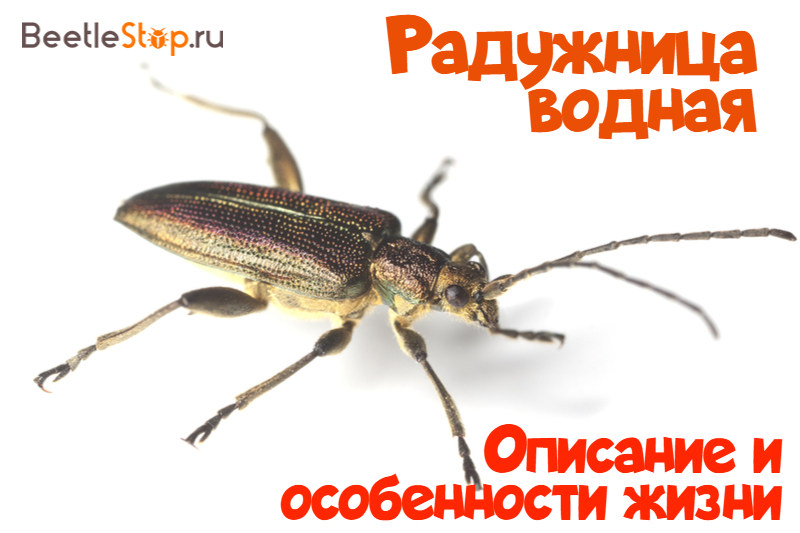Iris water - leaf beetle of fresh lakes and ponds
Iris is a small genus of the leaf beetle family. The bulk of the insects settled in the temperate zone of Eurasia and North America. Long-nosed beetles with bright brilliant coloring are found in abundance in fresh water bodies. A characteristic feature of iris flowers is their life cycle is closely related to aquatic vegetation. Adults feed on the surface parts, and larvae on underwater rhizomes. The iris is an aquatic small beetle with an unusually beautiful elytra color. They are active from May to July in sunny weather. For one year they give one generation.

Morphological description of the species
Iris water (Donacia aquatica) - a beetle from the family of leaf beetles, the genus of the iris. The Latin name Donacia - means "reed", it is associated with the feed plant of the insect. The Russian designation “iris” was due to the multi-colored iridescent coloring of the elytra of the imago. Body length 6-10 mm, males are smaller than females. The shape of the body is elongated, the head is small. Antennae long, filiform, 11-segmented. First segments enlarged, dyed in golden color like the rest of the head.
Facet type eyes. large and convex. The mouth organs are directed downward. Pronotum almost square, with right angles at base. Elytra elongated, tapering uniformly to apex. The color is iridescent, in some individuals it consists of green, golden, purple longitudinal stripes. Be sure to have a purple-red line on each elytra. There is a characteristic metallic luster. The underside of the body is golden, covered with long hairs. Limbs of different lengths: the front ones are the shortest, the rear ones are longer than the others. Thickened hips on all legs, hind with sharp tooth.
Distribution area
Iris is widespread in Europe, except for Portugal, Greece and some countries of Eastern Europe. In Russia, beetles live in the territory up to the Urals, Siberia and the Far East. Found in Japan.
Lifestyle
Insects in large groups stay near the water's edge. They fly from plant to plant, run. Activity is shown during the day, in fine weather. The peak is observed in the afternoon. In strong winds, with a decrease in temperature, they become sluggish. hide at night in the axils of the leaves. Sometimes beetles attracted by light fly at night. thick hair on the lower part of the body helps capture the air bubble when immersed in water.
Interesting fact. Leaf beetles of the species Donacia aquatica are able to move around the water and take off from its surface. They are difficult to catch, at the slightest danger the bug flies.
Adults appear after wintering in May (in some regions in April). By July, they are dying. They feed on the upper side of the leaves of sedge, marshy, chythorn, poppy heads, mannika. Beetles gnaw out the leaf parenchyma. After them remain strips that do not affect the epidermis of the lower part of the leaf plate. Insects also feed on pollen.
Breeding
Females place masonry on the underwater parts of plants or in their tissues. The eggs are oblong, white, covered with a jelly-like secret. Embryos develop 8-15 days. The larva of the iris is similar to the offspring of meat flies - maggots. The worm-shaped body consists of 3 thoracic and 10 abdominal segments. There are three pairs of legs.At the first age, the larva is 1 mm long, before pupation it will grow to 9-11 mm. On the head there are simple eyes, 3-segmented antennae, mandibles with two teeth. On the 8th segment of the abdomen are breathing hooks. The color is white or cream.
Larvae are poorly studied due to a secretive lifestyle. They develop in the root or stems of plants. Here they find food and air for breathing. Hollow spiked insects pierce plant tissue and consume oxygen from cells. Larvae have a tracheal system, but they never rise to the surface for respiration. In the process of feeding, the offspring of the iris does not cause much harm to feed crops. Larvae pass six ages.
Brown cocoons with pupae are attached to the roots of aquatic plants. The body of the pupa is white with a cream tint. It is smooth, bare, without spines and other outgrowths. Pupae complete development in late summer. Adults emerge from cocoons after the integument has finally hardened. They gnaw a hole at the end of the cocoon. Adult beetles can be active in the fall months, right up to the first frost. Some individuals, reaching adulthood, fall into hibernation and leave the cradle in May next year. Beetles that appeared in autumn winter on land among the remains of vegetation and leaves.
The total life expectancy of the iris is 3 years. The main part falls on the development of the larva. The offspring winters several times.

